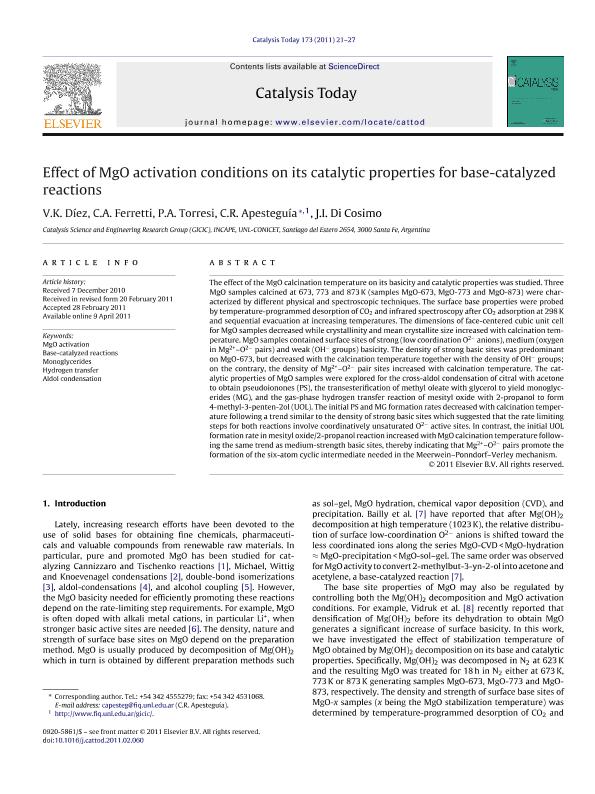Mostrar el registro sencillo del ítem
dc.contributor.author
Diez, Veronica Karina

dc.contributor.author
Ferretti, Cristián Alejandro

dc.contributor.author
Torresi, Pablo Antonio

dc.contributor.author
Apesteguia, Carlos Rodolfo

dc.contributor.author
Di Cosimo, Juana Isabel

dc.date.available
2023-09-18T14:53:02Z
dc.date.issued
2011-09
dc.identifier.citation
Diez, Veronica Karina; Ferretti, Cristián Alejandro; Torresi, Pablo Antonio; Apesteguia, Carlos Rodolfo; Di Cosimo, Juana Isabel; Effect of MgO activation conditions on its catalytic properties for base-catalyzed reactions; Elsevier Science; Catalysis Today; 173; 1; 9-2011; 21-27
dc.identifier.issn
0920-5861
dc.identifier.uri
http://hdl.handle.net/11336/211814
dc.description.abstract
The effect of the MgO calcination temperature on its basicity and catalytic properties was studied. Three MgO samples calcined at 673, 773 and 873 K (samples MgO-673, MgO-773 and MgO-873) were characterized by different physical and spectroscopic techniques. The surface base properties were probed by temperature-programmed desorption of CO2 and infrared spectroscopy after CO2 adsorption at 298 K and sequential evacuation at increasing temperatures. The dimensions of face-centered cubic unit cell for MgO samples decreased while crystallinity and mean crystallite size increased with calcination temperature. MgO samples contained surface sites of strong (low coordination O2- anions), medium (oxygen in Mg2+-O 2- pairs) and weak (OH- groups) basicity. The density of strong basic sites was predominant on MgO-673, but decreased with the calcination temperature together with the density of OH- groups; on the contrary, the density of Mg2+-O2- pair sites increased with calcination temperature. The catalytic properties of MgO samples were explored for the cross-aldol condensation of citral with acetone to obtain pseudoionones (PS), the transesterification of methyl oleate with glycerol to yield monoglycerides (MG), and the gas-phase hydrogen transfer reaction of mesityl oxide with 2-propanol to form 4-methyl-3-penten-2ol (UOL). The initial PS and MG formation rates decreased with calcination temperature following a trend similar to the density of strong basic sites which suggested that the rate limiting steps for both reactions involve coordinatively unsaturated O 2- active sites. In contrast, the initial UOL formation rate in mesityl oxide/2-propanol reaction increased with MgO calcination temperature following the same trend as medium-strength basic sites, thereby indicating that Mg2+-O2- pairs promote the formation of the six-atom cyclic intermediate needed in the Meerwein-Ponndorf-Verley mechanism.
dc.format
application/pdf
dc.language.iso
eng
dc.publisher
Elsevier Science

dc.rights
info:eu-repo/semantics/openAccess
dc.rights.uri
https://creativecommons.org/licenses/by-nc-sa/2.5/ar/
dc.subject
ALDOL CONDENSATION
dc.subject
BASE-CATALYZED REACTIONS
dc.subject
HYDROGEN TRANSFER
dc.subject
MGO ACTIVATION
dc.subject
MONOGLYCERIDES
dc.subject.classification
Otras Ingeniería Química

dc.subject.classification
Ingeniería Química

dc.subject.classification
INGENIERÍAS Y TECNOLOGÍAS

dc.title
Effect of MgO activation conditions on its catalytic properties for base-catalyzed reactions
dc.type
info:eu-repo/semantics/article
dc.type
info:ar-repo/semantics/artículo
dc.type
info:eu-repo/semantics/publishedVersion
dc.date.updated
2023-07-07T21:03:31Z
dc.journal.volume
173
dc.journal.number
1
dc.journal.pagination
21-27
dc.journal.pais
Países Bajos

dc.journal.ciudad
Amsterdam
dc.description.fil
Fil: Diez, Veronica Karina. Consejo Nacional de Investigaciones Científicas y Técnicas. Centro Científico Tecnológico Conicet - Santa Fe. Instituto de Investigaciones en Catálisis y Petroquímica "Ing. José Miguel Parera". Universidad Nacional del Litoral. Instituto de Investigaciones en Catálisis y Petroquímica "Ing. José Miguel Parera"; Argentina
dc.description.fil
Fil: Ferretti, Cristián Alejandro. Consejo Nacional de Investigaciones Científicas y Técnicas. Centro Científico Tecnológico Conicet - Santa Fe. Instituto de Investigaciones en Catálisis y Petroquímica "Ing. José Miguel Parera". Universidad Nacional del Litoral. Instituto de Investigaciones en Catálisis y Petroquímica "Ing. José Miguel Parera"; Argentina
dc.description.fil
Fil: Torresi, Pablo Antonio. Consejo Nacional de Investigaciones Científicas y Técnicas. Centro Científico Tecnológico Conicet - Santa Fe. Instituto de Investigaciones en Catálisis y Petroquímica "Ing. José Miguel Parera". Universidad Nacional del Litoral. Instituto de Investigaciones en Catálisis y Petroquímica "Ing. José Miguel Parera"; Argentina
dc.description.fil
Fil: Apesteguia, Carlos Rodolfo. Consejo Nacional de Investigaciones Científicas y Técnicas. Centro Científico Tecnológico Conicet - Santa Fe. Instituto de Investigaciones en Catálisis y Petroquímica "Ing. José Miguel Parera". Universidad Nacional del Litoral. Instituto de Investigaciones en Catálisis y Petroquímica "Ing. José Miguel Parera"; Argentina
dc.description.fil
Fil: Di Cosimo, Juana Isabel. Consejo Nacional de Investigaciones Científicas y Técnicas. Centro Científico Tecnológico Conicet - Santa Fe. Instituto de Investigaciones en Catálisis y Petroquímica "Ing. José Miguel Parera". Universidad Nacional del Litoral. Instituto de Investigaciones en Catálisis y Petroquímica "Ing. José Miguel Parera"; Argentina
dc.journal.title
Catalysis Today

dc.relation.alternativeid
info:eu-repo/semantics/altIdentifier/url/https://www.sciencedirect.com/science/article/pii/S0920586111002264
dc.relation.alternativeid
info:eu-repo/semantics/altIdentifier/doi/https://doi.org/10.1016/j.cattod.2011.02.060
Archivos asociados
